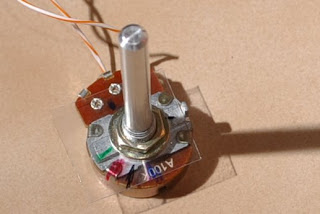 However, I found a SunPak Auto 2000 DZ Thyristor at Goodwill for $4.99. Unfortunately it only has one setting - full power. The power can't really be adjusted. While, browsing flickr, and other blogs I found some people who have "modified" their flashes in order adjust the light output.
However, I found a SunPak Auto 2000 DZ Thyristor at Goodwill for $4.99. Unfortunately it only has one setting - full power. The power can't really be adjusted. While, browsing flickr, and other blogs I found some people who have "modified" their flashes in order adjust the light output.I decided to give it a shot. Many older flashes have a light sensor (or something), that can sense when the light from the fired flash bounces back and hits the flash. It then cuts power. Two wires go to this sensor. It is usually a little hole on the front of the flash. On this strobe, the hole is surrounded by a florescent green circle.
 I opened up the flash, and cut the two wires leading to the sensor. I then went to Radio Shack and bought a potentiometer for $2.99. I bought the 100k-Ohm Audio-Taper Potentiometer (Product No. 271-1722). I first tried the linear potentiometer (based on another blogger's recommendation), but it didn't work as well. I soldered those two wires to the potentiometer.
I opened up the flash, and cut the two wires leading to the sensor. I then went to Radio Shack and bought a potentiometer for $2.99. I bought the 100k-Ohm Audio-Taper Potentiometer (Product No. 271-1722). I first tried the linear potentiometer (based on another blogger's recommendation), but it didn't work as well. I soldered those two wires to the potentiometer. I think I could probably do an exact job of marking of power settings if I owned a light meter. But instead, I set up the strobe next to a Nikon SB-800. I took photos with my SB-800, and then with the SunPak, adjusting the light output of the SunPack to match the images from my SB-800. (Both strobes were set to 35mm). This picture has my SB-800 (left) next to my SunPak. When I did the test shots I actually aimed the strobes at an object to compare the light.
I think I could probably do an exact job of marking of power settings if I owned a light meter. But instead, I set up the strobe next to a Nikon SB-800. I took photos with my SB-800, and then with the SunPak, adjusting the light output of the SunPack to match the images from my SB-800. (Both strobes were set to 35mm). This picture has my SB-800 (left) next to my SunPak. When I did the test shots I actually aimed the strobes at an object to compare the light. At full power my SunPak equals the power of the SB-800 at 1/4 power. I was able to mark off stops on my SunPak at 1/4, 1/8, 1/16, 1/32, 1/64, and 1/128. Pretty cool! It worked much better than I anticipated. I used a different color sharpie to represent different light output.
At full power my SunPak equals the power of the SB-800 at 1/4 power. I was able to mark off stops on my SunPak at 1/4, 1/8, 1/16, 1/32, 1/64, and 1/128. Pretty cool! It worked much better than I anticipated. I used a different color sharpie to represent different light output.I still need to make it look prettier, but right now it is function over form. Here are some samples of varying output:







Here are a few links to people who posted some good info:
Most of the information came from here: kaisphotos on flickr
Some more reading here (good but not as useful):
No comments:
Post a Comment